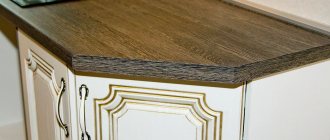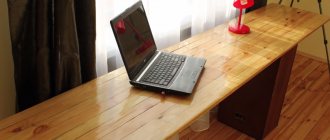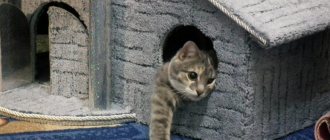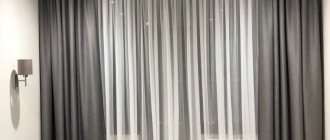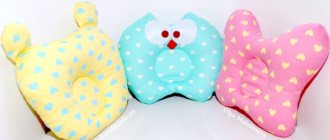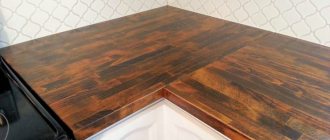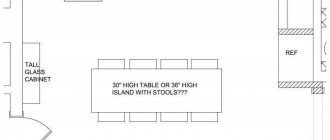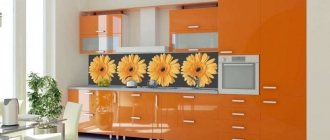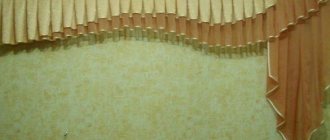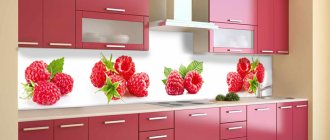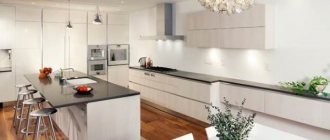Kinds
A very important role is played by the protective strip of the dishwasher - the same one that is also a sink. Thanks to it, moisture and dirt do not get inside the cut in the form of:
- drops;
- splash;
- condensate;
- fat;
- water vapor;
- cuts of meat, vegetables.
The corner model is used mainly where it is necessary to connect the elements of the tabletop itself. Basically, such products are produced on the basis of aluminum alloys. This guarantees:
- high strength;
- easy cleaning;
- attractive decorative properties of metal surfaces;
- versatility of colors, perfectly combined with a variety of tones in the design;
- resistance to temperature fluctuations and humidity (for a steel model such corrosion resistance is difficult to achieve).
The slot strip in most cases belongs to the already mentioned protective category. Please note: such products may also be called docking or connecting strips. There are no strict standards here. The overlay structure can also play a protective role, but one must understand that it is only suitable for straight surfaces. There are also rear and front, wide and narrow, front and side, T-shaped and U-shaped, right and left plank structures.
The difference may also apply to the base material. Of course, wood and ferrous metal are not used. However, the already mentioned aluminum and stainless steel have serious competitors. In some cases, the bar is improvisedly replaced with a thick silicone strip. This is a practical, but not very attractive solution.
Features of processing natural and artificial stone
Processing various types of natural and artificial stone has its own characteristics, which are associated with the characteristics of the material.
- Granite is highly durable, so you can choose any type of edge. Cracks and chips rarely appear on the surface even with intensive use.
- Marble is a softer and more pliable material. Therefore, experts do not recommend using shaped profiles on it. Both during work and during operation of the tabletop, cracks may appear on it. To process marble ends, it is better to choose straight and clear lines.
- Quartz stone (quartz composite stone, quartz agglomerate) is a combination of natural quartz mineral, high-quality polyester resin and color pigments. Moreover, the share of natural quartz, one of the most durable natural materials, is 91-93%, depending on the manufacturer, the remaining 7-9%, respectively, comes from resins and pigments. Sometimes quartz stone is called artificial stone, but it should not be confused with artificial (acrylic) stone, which does not contain natural ingredients.
- Acrylic stone (solid surface) is a modern composite material. The main components of artificial stone are acrylic resins Methyl methacrylate (MMA) and Polymethyl methacrylate (PMMA), aluminum hydroxide, natural mineral fillers and pigment additives. Often called simply artificial stone. Polymethylmethacrylate is one of the most expensive components of acrylic stone, which ensures its strength, durability and aesthetic qualities. The more it is in the composition, the more expensive and better the stone. Acrylic stone becomes plastic under the influence of high temperature - 150-200 ° C, since it is a thermoplastic, which allows the use of thermoforming technology for its molding.
- Dekton. This material makes it possible to install large-format parts without cuts or joints, creating unified spaces that are harmoniously integrated into various styles. Dekton is based on some of the hardest minerals on the earth's surface. There are no chemicals or clay raw materials. Highest flexural strength. Lowest abrasion rate. Dekton creates clean, pleasant-to-touch surfaces. They are resistant to common kitchen hazards and are durable. The edge of this type of material can only be straight.
- The cost of processing the ends depends on the thickness and properties of the stone. Curly parts are more difficult to process than straight ones, but in the end the kitchen owner receives an original kitchen set that will attract the attention of guests at home.
- To give the tabletop an attractive appearance, adhesives made of various materials are used. They can be made of plastic, wood and even metal. Installing these elements allows you to make the side edge of the tabletop thicker, protecting it from mechanical influences, moisture and other negative factors.
Characteristic
Countertops used in kitchens are mainly made from particleboard. They are additionally coated with a material that increases the wear resistance of the surface. But the problem is that there is no such protection at the bottom and along the edges. If the lower part of the structure is still completely hidden from prying eyes, and can be safely ignored, then it is almost impossible to do without protective end strips for the tabletop. Otherwise, a lot of dirt and dust will collect there; the effects of strong heat should not be ignored either.
Each bar has its own specific work profile. It is customary to distinguish between end and connecting (also known as slot or, otherwise, connecting) modifications. The first type allows you to close insufficiently processed edges. Where there are end strips, the following do not get cut:
- liquids, including water;
- condensate;
- spray.
End strips are considered universal because the same type can be installed on countertops of any format, even with pronounced curved geometry. Installation is usually done using self-tapping screws. They are inserted through special holes prepared in advance. The second type of planks performs such an important task as decorating the junction of two parts of the headset.
Typically an aluminum strip is used. Contrary to popular belief, it is by no means thicker than its steel counterpart. Moreover, elegant appearance and resistance to food acids mean a lot. “Winged metal” is lighter than steel, which may not seem too significant, but saving on weight is never superfluous. The service life of aluminum is quite long, and it can be used almost unlimitedly.
Tools
If you decide to glue the edge yourself, check that you have the tools. Prepare before starting work:
- Iron, which is necessary for gluing with melamine edge;
Furniture edges can be glued at home using a regular iron.
A hair dryer is the most convenient method of heating the edge.
It will become a convenient device for pressing the edge tightly.
The processed ends are smoothed with it.
You will need scissors to cut the desired length of the edge.
It cuts off the excess edge hanging from the edges of the part.
Use glue if your material does not have an adhesive base.
With a solvent you can easily remove traces of glue.
It is convenient to remove excess glue with a rag soaked in solvent.
To fix the PVC edge, you can use a clamp and a wooden block. If possible, use a hand router to finish the edging.
The router is expensive and it is not profitable to buy it for one-time pasting.
Prepare your workspace, taking into account the space for turning the tabletop. And, most importantly, buy the appropriate melamine tape or PVC edge.
Choose a ribbon that matches the color of the countertop.
What are they?
In the assortment of modern manufacturers, corner profiles play an important role. Of course, they are used to connect parts of the tabletop mechanically end-to-end at a certain angle. The name “docking” is usually assigned to an element that is mounted at a right angle and plays an increased decorative role. The end product covers the initially uninsulated end and prevents negative impacts on it from the external environment. The thickness and radius of a particular option always play a key role in selection.
But it is always necessary to clarify what exactly the manufacturer or supplier means by a certain item in the catalogue/contract, receipt or price tag (label). So, slotted strips are just an alternative name for connecting profiles. It’s just that the terminology in this area is not yet well established, and one cannot count on uniformity of names. Another example is that the concepts of wide and narrow bars have little to say to the consumer.
The T-shaped model has an important specific feature - it ensures the most accurate and careful connection of the parts of the tabletop. Even if these parts are very heterogeneous in terms of geometry and mechanical qualities, the creation of an integral composition is guaranteed
Most often, profiles are made from aluminum alloys, since this particular substance - not ferrous metal, not plastic or stainless steel - has a number of important advantages:
- chemical inertness;
- ease;
- strength;
- reliability;
- pleasant appearance;
- resistance to high and low temperatures, water vapor, fats and organic acids;
- hypoallergenic.
A very relevant characteristic is the size of a specific bar. You can often find designs with a thickness of 26 or 38 mm. Such products in many cases have a length of 600 mm - and this size ratio was chosen by engineers based on familiarity with the practice of use and reviews.
But many companies are ready to offer profiles of other sizes. Thus, planks with a thickness of 28 mm are regularly found in the catalogs of furniture companies. These can be simple connecting, end, and corner structures. But models with a size of 42 mm usually need to be ordered additionally - they are a rarity in manufacturers' catalogs. However, with the modern variety of furniture workshops, this, of course, is not a problem.
What is important is that a rounded bar, regardless of its dimensions, is the safest. This property will be most appreciated by those who have small children at home.
However, even for the most brutal adults, an unnecessary collision with a sharp angle is unlikely to evoke positive emotions.
Finally, it is worth considering the topic of painting the connecting strips. Like the countertops themselves, in most cases they are black or white. But the choice of users naturally does not stop there.
Thus, in interiors that are neutral in spirit, many users consider a beige tone to be the best solution. It perfectly suits the “kitchen” mood and does not excite the nerves too much. Sand color is suitable for rooms with light wooden facades. It is also good where the design is different, but there is a lot of light.
Other main options:
- metallic - for practical people who love to cook in their kitchen;
- dark brown color - an expressive rich contrast in a very light interior;
- green (including both herbal and light green) is an excellent choice for romantics, for families with children, for those who are not used to being discouraged and upset;
- red - a bright accent against a white or moderately dark background;
- orange is an excellent combination with brown or other moderately saturated colors of furniture;
- pink - creates a spectacular and at the same time devoid of any aggression mood;
- oak - expresses traditionalism, solidity and respectability;
- A milky white shade is suitable for diluting a very dark-looking kitchen.
Features of choosing glue for PVC edges
Today, the use of hot melt adhesives is common. This is a very high-quality material, so special equipment is provided for its use. This is inconvenient if you need to glue the edge to the tabletop at home one time.
The use of PVC glue is common. It perfectly attaches the paper base to different materials. The only negative is that it does not tolerate moisture, so it is not used for kitchen tables.
It is optimal to use universal adhesives. They provide reliable fastening and are not afraid of moisture. It takes up to four hours for the layer to dry, then the tabletop is put into operation. Such compositions are available, most importantly, they are safe for the body. An example is Kleiberite 501. This is a polyurethane, one-component adhesive. It is heat and water resistant and can withstand group D4 loads. Hardening occurs when exposed to moisture from the air.
Tabletop connection
Required Tools
Whatever the type and color of the plank for the countertop and the countertop itself, it will have to be carefully installed. Connecting a pair of chipboard panels together is the only option for obtaining a corner structure. For work you will need, in addition to the bar itself:
- a pair of clamps (ties) for the tabletop;
- silicone-based sealant (colorless composition is recommended);
- household electric drill;
- metal saw;
- metal drills;
- Forstner drills of various sections;
- Phillips screwdriver or screwdriver;
- 10mm wrench;
- pliers;
- stationery pencil (the hardness of the lead is not important);
- a soft scrap cloth to wipe off excess sealant.
Technology
Let's say you need to join a pair of chipboard panels at an angle. In this case, a “no segment” connection can be practiced. Simply place 2 sections on the kitchen cabinet at right angles. But docking “through a segment” can also be made. This solution is more cumbersome. They resort to it so that they can install a corner cabinet.
In any case, the joint should be as tight as possible. The smaller the gap separating the ends, the better. Of course, it is difficult to achieve such a result on oval or rounded countertops. But even in this case, it is not necessary to call installers. You can simply install a special corner connector - its cost is much lower than the cost of the services of a specialist (who, moreover, will most likely buy a similar product).
A more aesthetically pleasing option for installing prefabricated countertops is to attach them using the so-called Euro-sawing method. This approach is suitable for products regardless of the edge shape. In such a case, the plank will have a more auxiliary and decorative role. It will only provide additional reliability for the connection of elements. The main fixation will be done by sealant and wood glue.
But euro saw is rarely used due to its high cost. In most cases, functional joining profiles are still used. Before marking the positions of the clamps, you need to make sure that the fastening will not interfere with the installation of the equipment in the countertop. And not only appliances, but also built-in sinks.
Another circumstance is that even if there are several ties, the prefabricated product will definitely be inferior in rigidity to the monolith. Therefore, the tabletop at the bottom will have to be firmly supported. After marking the screed points, the connecting strip will need to be attached to the end of the tabletop. Next, future new slots are marked with a pencil. A metal saw will help you make cuts along the lines.
Next, the internal excess is broken off with pliers. Using a hacksaw, saw off the plank to the desired size, leaving only a margin of 1-2 mm. The last thing to worry about is the reliable immersion of the screw heads. They should fit flush into the bar; if this is not ensured automatically, resort to additional countersinking. Next steps:
- using a 35 mm Forstner drill clamped in a drill, knock out blind holes to a predetermined depth, which guarantees the placement of the clamp pin exactly in the middle of the thickness;
- Having prepared blind holes, make 8 mm holes in the tabletop for studs;
- for the sake of increased accuracy, this hole is passed sequentially with a pair of drills;
- open longitudinal grooves are prepared in the countertop;
- tighten the connecting strip on the tabletop with self-tapping screws;
- cover the strip with sealant;
- insert the pin into the groove and into the hole of the mating part;
- evenly (one by one) tighten the parts of the tabletop with a wrench;
- As soon as the sealant begins to stick out, stop tightening and wipe the stain with a cloth.
Features of connecting strips for countertops in the video below.
We glue furniture edges with our own hands
There are two technologies for gluing furniture edge tape. The first is for those that have glue applied to the back. In this case, an iron or a hair dryer is needed. The second is for gluing tapes without glue. In this case, you need a good universal glue that can glue plastics and wood products and a furniture roller, a piece of felt or a soft rag so that you can press the edge well against the cut.
A little about what thickness of edge to glue on which parts. Those edges that are not visible, according to GOST, do not need to be glued at all, but basically they try to treat them so that less moisture is absorbed into the chipboard, and also to reduce the evaporation of formaldehyde. Melamine tape or 0.4 mm PVC is glued to these edges. The edges of the drawers (not the fronts) are also processed.
It is better to use 2 mm PVC on the front ends of the facade and drawers, and 1 mm PVC on the visible sections of the shelves. The color is chosen either to match the main surface or “in contrast”.
How to glue edging yourself with glue
The adhesive composition is applied to the melamine edge; it can be applied to PVC. If you choose PVC, it’s easier to start with thin ones - they are easier to process, any melamine is easy to glue.
We take an iron and a fluoroplastic nozzle on it. If there is no nozzle, thick cotton fabric will do - so as not to overheat the tape, but to melt the glue. A hair dryer is also suitable for this purpose. We set the iron to about “two”, while it is heating up we cut off a piece of tape. The length is a couple of centimeters longer than the workpiece.
We apply the edge to the part, level it, smooth it out. There should be small pieces hanging off both sides. We take an iron and, using a nozzle or a rag, iron the edge, heating it until the glue melts. It is necessary to heat evenly over the entire surface. After the entire edge is glued, let it cool. Then we start processing the edges.
The edge can be cut with a knife, both with the sharp and blunt sides. Some people use a regular metal ruler, while others find it more convenient to use a stainless steel spatula.
So, take the tool you have chosen and cut off the hanging edges of the edge. They are cut close to the material. Then cut off the excess along the part. Melamine and thin plastic are easily cut with a knife. If the PVC edge is thicker - 0.5-0.6 mm or more, difficulties may arise. Such edges are possible if there is one. This guarantees good results in a short time. The processing will take longer if you use sandpaper, but the result may not be worse.
One important point: when gluing thin edges, the cut of the part must be smooth, without protrusions and depressions. The material is plastic, which is why all defects are visible. Therefore, first go over the cuts with sandpaper, then thoroughly remove dust and degrease. Only after this can you glue.
Edging with PVC tape (no glue on the back side)
With this method of gluing PVC edges yourself, you need universal glue and a piece of felt or rag. We read the instructions for the glue and carry out all the steps as recommended. For example, for Moment glue, you need to apply the composition to the surface and distribute it, wait 15 minutes, and firmly press the surfaces to be glued.
Apply glue and wait - no problem. To press the edge tightly to the cut, you can use a wooden block wrapped in felt. Instead of a block, you can take a construction float and also attach felt to its sole. As a last resort, you can roll up thick fabric in several layers and press the tape to the surface.
The selected tool is pressed against the laid edge, pressed with all its weight, pressing it to the surface of the chipboard. The movements are stroking. This is how they iron the entire edge, achieving a very tight fit. The part is left in this form for some time - so that the glue “seizes.” Then you can start processing the edges.
Fastening
In the vast majority of cases, the installation of countertop slats is carried out during furniture assembly. But sometimes people try to save money or there is a need to replace products. Then you should install them yourself. For work you will need a sealing agent and self-tapping screws. Please note: if there are no holes for fixing, drill them yourself.
The sealant must be applied around the entire perimeter of the installation. The standard installation method implies that the strip will be secured with self-tapping screws last, when the sealant has already set tightly
Important: do not confuse left and right products, as in this case they will look unaesthetic. Another subtlety, which, unfortunately, is often forgotten, is cleaning the surface before applying sealant.
You should not categorically cover the joint between the apron and the tabletop using a flexible plinth. This approach immediately reveals very greedy people with poor aesthetic taste. The best option is to order the baseboard along with the tabletop itself. If for some reason this is impossible, you should at least contact the same company where it was made with such an order. Then no problems can arise. There are also other options:
- medium-length plinth ("apron without apron" system);
- an improvised side from the apron itself;
- use of epoxy-based grout;
- use of sealant (helps when joining products from a variety of materials).
The end of the bar often needs to be modified. This is expressed in the removal of a hard rib. It can be very annoying later on. Screws and self-tapping screws should be screwed in carefully, but all the way. If this is not possible, you will have to enlarge the hole or change the hardware.
How to glue an edge without adhesive
If you have an edge without an adhesive layer, then the glue will have to be purchased separately. After cutting the edge to the desired length, apply adhesive. Moreover, it is better to lubricate both the edge and the end with glue to ensure better adhesion. Then press the edge using a stiff roller.
If you do not have the opportunity to purchase an edge with an adhesive layer, you will have to buy glue along with the edge.
Gently roll the roller along the edge several times. If excess glue appears, remove it immediately with a damp cloth. After the glue has completely dried, carefully trim the edge.
Installation
Or it becomes unusable over time and requires replacement. There is no need to be afraid of such work - it is quite within the capabilities of the most ordinary people. All that is required is sealant and self-tapping screws of a certain cross-section. Only in some cases, when there are no holes in the tabletop itself, either at all, or in those very necessary places, it is necessary to drill it. One way or another, after making sure that all the required holes are ready, apply sealant; Then all that remains is to screw the product with self-tapping screws and calmly use it.
Drilling artificial or natural stone is done with a drill at the lowest speed.
Types and installation of planks in the video below.
PVC strip
A more progressive and aesthetically pleasing way. True, its implementation requires some skill, but after practicing on scraps, you can master this method.
The edge, resistant to abrasion and moisture, will ensure long-term use of the tabletop in any interior.
When gluing the PVC edge, follow the following sequence.
- Cut a strip of finishing material 2 cm longer than the edge to be processed.
- Heat the edge with a hair dryer on the glue side or with an iron on the front side.
To glue the edges, use an industrial hair dryer with a heating temperature of 250 degrees.
If you are using a material without an adhesive base, use “88-Lux” glue or something similar.
Apply to the cut strip and wait for the time specified according to the instructions. In 2-3 minutes. Before the end of the period, cover the end of the tabletop with a thin layer of glue.
The blade of the knife should go along the plane of the part, thus evenly cutting off the protruding part of the edge.
The edge treated with fine-grit sandpaper will be even and smooth.
A properly selected and glued edge will give the tabletop an attractive appearance, and it will serve you for many years.
You can also get such a smooth and neat edge yourself.
Characteristic
A countertop plank is a product that is responsible for the aesthetic characteristics of the structure as a whole, for its visual perception. And it’s not worth separating even such a seemingly abstract moment as the coloring of the plank from the tonality of the main element. Traditionally, lunch in the kitchen is usually spent at a table with a white or very light profile. There is absolutely no point in challenging this old, time-tested practice. But there are times when only professional designers can make the right decision.
Often the color is selected taking into account the colors of the lower hanging or floor cabinets. But the opposite solution is often practiced (with the task of conscious contrast).
They are valued for their visual luxury and sense of good taste.
What is important is that such effects are achieved very simply and without any significant additional effort.
But you should think about choosing this or that color later, but for now it’s useful to go back a little and figure out what the design itself is. A universal sealing block is in demand because the tabletop is continuously exposed to intense mechanical (and other) influence. And apartments often lack the basic production length of countertops, which is 3-4 m. Of course, they are extended, but the places where they are extended are always subject to destruction, and this will be confirmed by any engineer or a person who simply understands physics. The flexible wall profile solves the same problem as the front edge material, but its placement is somewhat different, as the name already says.
Description and purpose
From time to time, when arranging their homes and during major renovations, people try to update their furniture. In this case, it has to be modified frequently. This also applies to kitchen sets and their components. You can do this work yourself without any problems. Of course, for this you will need just the connecting strips for the countertops.
Such products are designed, as their name suggests, to connect dissimilar parts of the structure with each other. It should be noted that the docking assistant, along with a purely practical function, is no less responsible for the aesthetic filling of space. Where they are installed, the edges do not crumble or swell from drops and water vapor. Similar products are placed at the joints; They are also usually used to decorate the corners of furniture.
You should purchase the planks in the same place where the furniture itself was purchased. This significantly reduces the risk of error and technical failure. It is recommended not only to get acquainted with the catalogs, but also to consult with specialists. In favor of special connecting products they say:
- attractive appearance;
- excellent resistance to corrosion and mechanical damage;
- long period of operation;
- Suitable even for wet conditions, for contact with sharp objects and caustic, aggressive substances;
- compatible with postforming countertops.
Useful tips
Every furniture maker has little tricks that help get the job done quickly and efficiently:
- The purchased edge may or may not have an adhesive applied. The list of tools and materials, as well as the work algorithm, will depend on this. If there is an adhesive layer, then, placing the edge against the end, go over it with an iron (at low temperature or in the “synthetic” mode), or with a hair dryer. Be sure to ensure that the cut surface is completely covered by the edge.
- Start heating only after you are sure that the edge lies flat and there are no waves or bends. The material is ironed until the edge has cooled completely.
- If you are unable to purchase special glue, use universal glue. For a strong connection, the surfaces must be clean, free of dust and crumbs.
- To make the connection as strong as possible, apply glue to both surfaces. And for smoothing, use a hard roller; it is better if the rolling surface is small.
- The protruding parts are removed only after the adhesive has “set.” And the chipped areas are treated with fine sandpaper.
Remove any remaining edges with a utility knife.
This kind of work can be done even without special skills and professional equipment. There are simply certain rules and features of the work process that you should have a clear understanding of.
Do-it-yourself tabletop edging at home is a simple process
Let us immediately note that if you use high-quality materials and adhesives, the work process will not be difficult for you. It is quite possible to use ordinary household appliances (iron, for example) as tools.
But furniture made or repaired by yourself is guaranteed to create coziness and comfort in your apartment.
Choose a quality edge!
Choice
But limiting ourselves to size alone is not everything.
In order for the plank for the end of the tabletop to fulfill its function clearly, you need to pay attention to other subtleties. So, along with aluminum products, plastic structures can sometimes be used
But they are not durable enough and are easily damaged by sharp objects, so you can choose such models only as a last resort when there is an acute shortage of funds. Metal structures should ideally have a matte appearance so that any roughness is less noticeable; Otherwise, it is enough to consult with sellers or countertop manufacturers.
Profiles for processing furniture edges
You can trim the edge of furniture not only with edge tape. There are also furniture profiles that are attached mechanically. They are available in two sections - T-shaped or U-shaped (also called C-shaped).
For T-shaped furniture profiles, a groove is milled in the edge being processed. The profile is hammered into it with a furniture (rubber) mallet. The edges are cut at 45° to make the angle look attractive. It is brought to perfect condition with fine sandpaper. This type of profiles is produced from PVC and aluminum; with the same installation method, they look very different, and the differences are significant.
In width they are available for laminated chipboards of 16 mm and 18 mm. There are also wide ones, but they are much less common, since they work less with such material.
C- or U-shaped profiles are most often mounted with glue. They coat the edge with it, then put on a plastic profile, press it well and fix it. These PVC profiles are soft and hard. Hard ones are harder to bend and it’s difficult to paste them over curved edges. But they have great strength.
If you still need to “fit” a rigid C-shaped furniture profile onto a bend, it is heated with a hair dryer, then given the desired shape and secured with masking tape until the glue dries.
